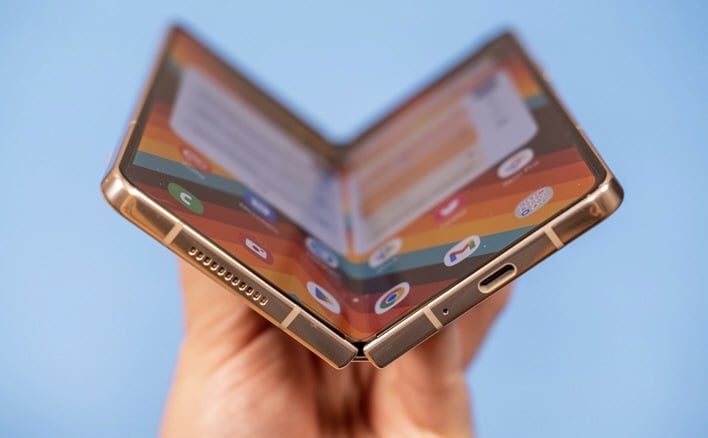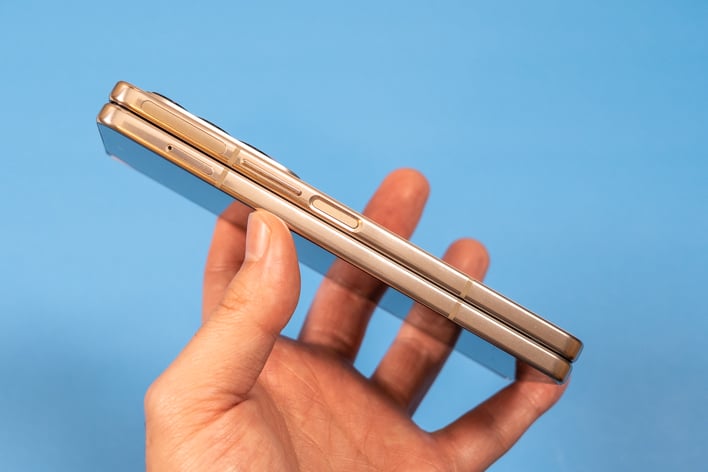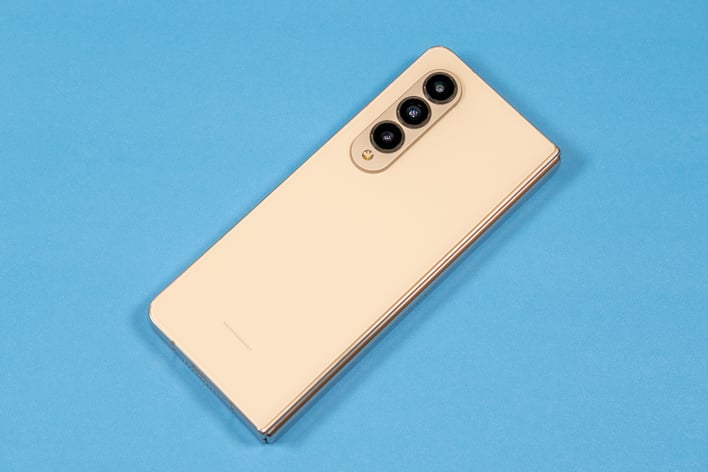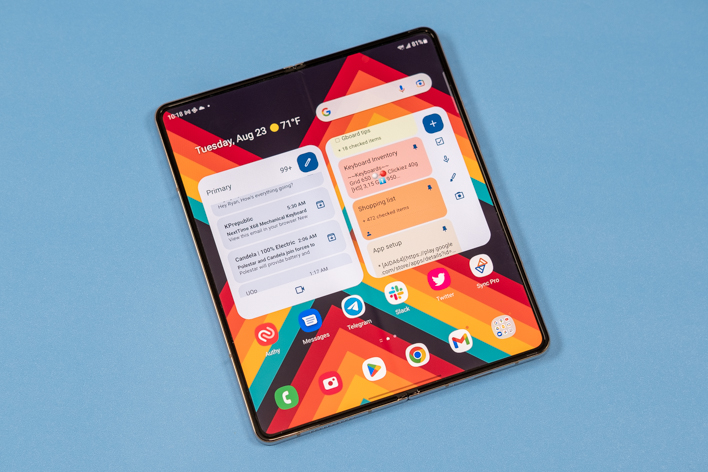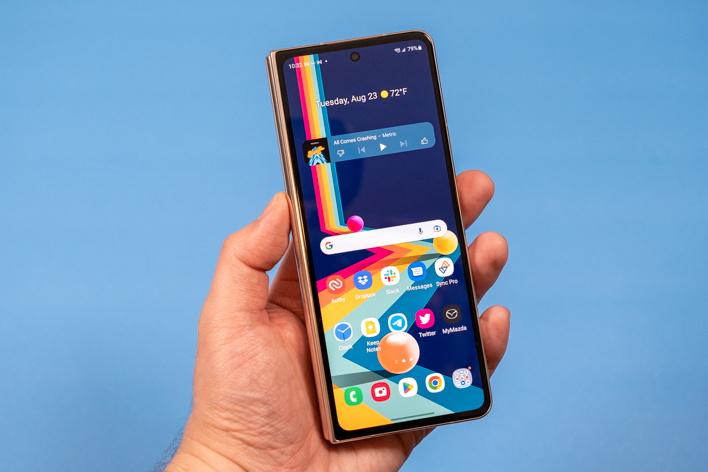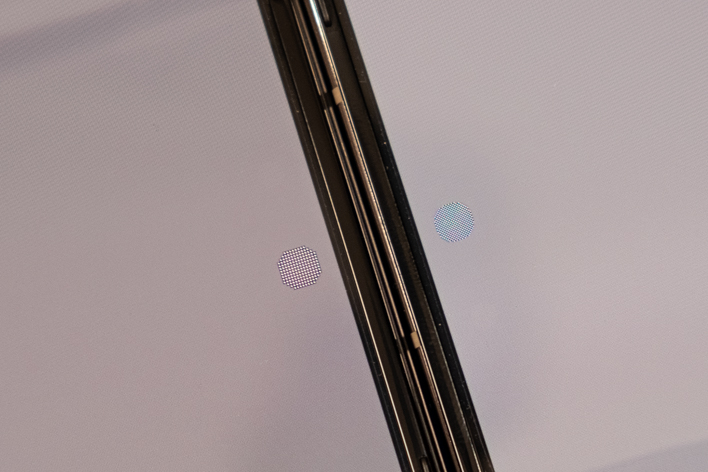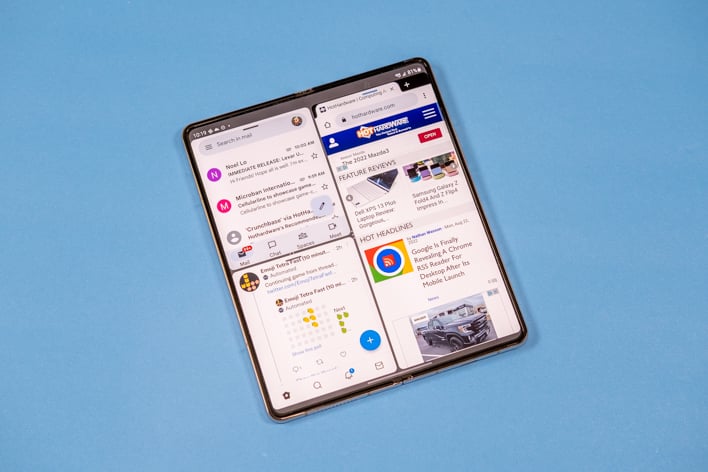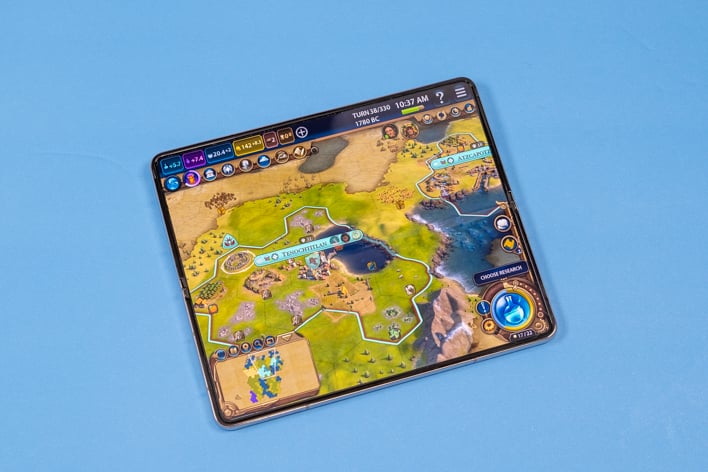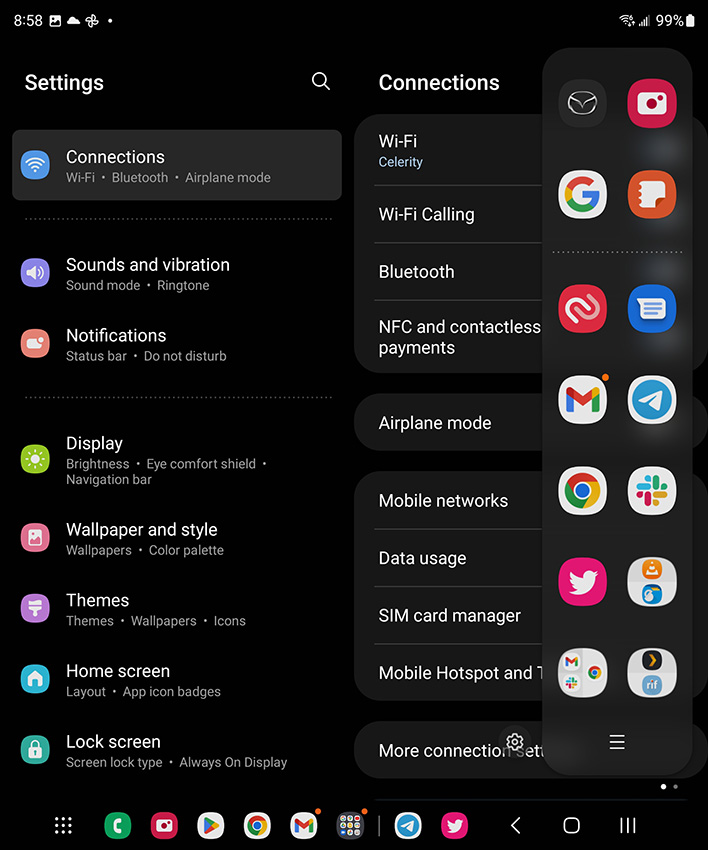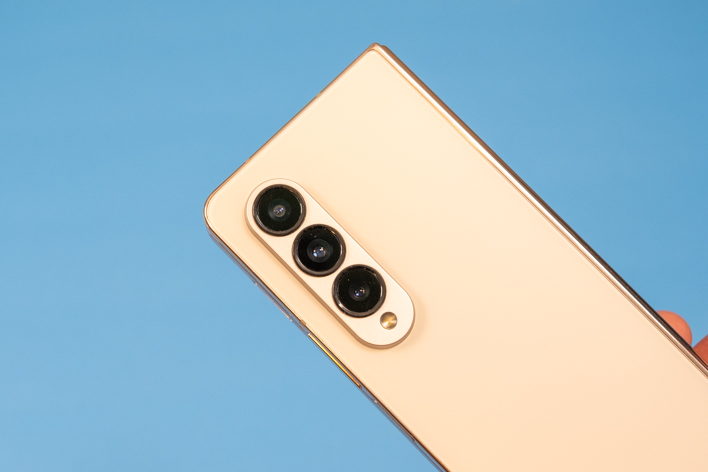Samsung Galaxy Z Fold 4 Review: A Fabulous Foldable Phone
Samsung's Galaxy Z Fold 4 Offers The Most Powerful Computing Experience That Fits In Your Pocket
| Samsung Galaxy Z Fold4 - Starting At: $1799.00 Samsung made some great refinements to the Galaxy Z Fold4 over the previous gen Fold3, including a better camera, better build quality and a fantastic folding display. However, its battery life is middling and its price tag still hefty.
|
|||

|

 |
||
According to Samsung, foldable phones are the next big thing. Just a few years ago, such a thing would have sounded ludicrous, but this fourth generation of Samsung foldable phones has shown what iterative improvements can do. With the Galaxy Z Fold4, Samsung has created what may just be the most powerful and useful computing device that can fit in your pocket. But innovation comes at a price—about $1,800 to be precise.
It's hard to imagine any mobile experience that would justify that kind of price tag, but the Z Fold4 gets closer than ever before. Not only does it have Samsung's latest and greatest foldable OLED technology, it sports the fastest Android platform processor currently, the longest software support and impressive build quality, for something that folds in half. Samsung even addressed camera performance, which was one of our primary pain points with the Fold3. The Fold4 doesn't feel like an experiment anymore, though perhaps it's still not quite ready to supplant the Galaxy S family at this price. This Galaxy is definitely feature-packed, however, so let's dive in deep...but first, here's a quick hands-on look at everything Samsung launched along with the new Z Fold4...
Samsung Galaxy Z Fold 4 Features And Specs
| SoC |
Snapdragon 8+ Gen 1 (4 nm) |
| Display | 6.2-inch 904 x 2316 OLED @ 120Hz, 7.6-inch foldable 1812 x 2176 OLED @ 120Hz |
| Memory |
12GB |
| Storage |
256GB, 512GB, or 1TB UFS 3.1 |
| Rear-Facing Cameras |
50MP primary (OIS, f/1.8), 12MP ultrawide ( 123 degrees, f/2.2), 10MP telephoto (3x, OIS, f/2.4) |
| Front-Facing Cameras |
10MP f/2.2 (cover), 4MP f/1.8 (UDC) |
| Video Recording |
Up to 4K 60FPS |
| Battery |
4,400mAh, 25W charging |
| Authentication |
Side-mounted fingerprint sensor (capacitive) |
| OS |
Android 12 (One UI 4.1.1) |
| Dimensions |
Unfolded: 155.1 x 130.1 x 6.3 mm; Folded: 155.1 x 67.1 x 14.2-15.8 mm |
| Weight |
263g |
| Dust/Water Resistance |
IPX8 |
| Connectivity |
802.11ax Wi-Fi 6e, Sub-6GHz and mmWave 5G, Bluetooth 5.2 |
| Colors |
Graygreen, Phantom Black, Beige, Burgundy (Samsung exclusive) |
| Pricing |
Starting At $1,799.99 - Preorder Deals Now |
The Galaxy Z Fold4 is the larger of Samsung's foldables, with a 6.2-inch cover display and a 7.6-inch foldable display on the inside. The basic design hasn't changed compared to the Z Fold3, but anyone who has spent the last year using a Samsung foldable will quickly notice a plethora of small refinements. For example, the frame is rolled a bit more near the hinge, which allows the two halves to meet more precisely. It feels more like a tablet when unfolded rather than a phone that folds in half.
Samsung still hasn't found a way to add its class-leading ultrasonic fingerprint sensor tech to foldable screens—there's a side-mounted capacitive sensor in the power button. Although, it's a stable, tactile button that's easy to press. Fingerprint recognition is also lightning fast.
The back of the phone is Gorilla Glass, and is available in several nice, understated colors (ours is "Beige"). You really have to hand it to Samsung for its glass treatment—it feels more like ceramic than glass. It's smooth but not slippery, and we vastly prefer this subtle texture to the rough stone-like finish on phones like the OnePlus 10T. The Fold4 also costs more than three times as much as that phone, so it better feel fancier.
The Fold4 has the flagship specs you'd expect for an $1,800 smartphone. At its heart is the Snapdragon 8+ Gen 1, the same chip we saw in the OnePlus 10T. It includes one 3.2GHz Cortex-X2 core, three 2.75 GHz Cortex-A710 cores, and four 2.0 GHz Cortex-A510s. The clock speed is 10% higher than the non-plus Gen 1 chip. The Adreno 730 GPU is also the fastest graphics engine you'll find in Android devices right now.
The base model Fold4 includes 256GB of storage and 12GB of RAM. You can pay more for additional storage (there's no microSD card slot) up to 1TB, but the price is already astronomical. There are phones out there with more RAM and storage, but the Fold is competitive among all flagship phones.
Samsung Galaxy Z Fold4: Two Screens, One Phone
When closed, this phone is a brick measuring 15.8mm thick at the hinge. It will bulge out of your pocket in an unsightly fashion, but it's not that much more uncomfortable to carry than an enormous flat phone like a Galaxy S22 Ultra or iPhone 13 Pro Max. The Fold4 is usable when closed, but even the edge opposite the hinge is 14.2mm thick—it can be a real hand-stretcher. However, we do like the slightly larger cover display, which is 3mm wider than last year's phone. That may not sound like a lot, but the screen is so narrow that every little bit helps. Some apps that just refused to render correctly on the Fold3's narrow screen, like Google Home, are much more usable on the Fold4.When unfolded, this device is only slightly smaller than the 2021 iPad Mini, so most people will be able to grip it with one hand. The aluminum frame is extremely solid, and that rigidity extends to the hinge. There's no creaking, no wobble—the movement is smooth and satisfying. The phone can also tell when the hinge is bent but not closed, enabling the software to activate "Flex Mode," which allows supported apps to load a special UI that takes better advantage of the form factor.
Samsung's first few foldable OLEDs came with serious durability concerns, but each generation has boosted the flexible panel's strength. In the case of the Fold4, Samsung says an improved ultra-thin glass layer made the screen 45% stronger. The top layer is still a plastic screen protector, but the feel is getting surprisingly close to a glass display with a plastic screen cover on top. The Fold4 supports the S Pen stylus on the internal screen like the Fold3 did, but you still have to use the Fold Edition pen. The tip retracts when too much force is applied in order to protect the screen—using a different model S Pen could damage the screen. It's still much softer than your average slab of Gorilla Glass, something Samsung warns you about as soon as you turn the phone on for the first time.
Given our experience with the Fold3 hardware over the past year, we have no reason to expect the hinge will be a problem long-term even if you're folding and unfolding all day. It can be fun to fiddle with, and we especially love the sharp "clack" when it closes. The fact this phone folds in half and is also water-resistant is a testament to Samsung's engineering prowess.
The internal screen has an impressive resolution of 1812 x 2176, and the brightness (1,200 nits) isn't bad, either. Combine that with the 120Hz refresh rate, and you have an unimpeachably-good tablet screen that folds up in your pocket. Well, some people are bothered by the crease, which runs top to bottom right down the middle of the display. Comparing the Fold4 to the Fold3, the crease does seem less pronounced, but it's something you stop noticing after a while. The internal screen is 3mm wider this year just like the cover screen. It makes less of a difference on a 7.6-inch screen, but it's still appreciated as the almost square screen is excellent for multitasking.
Samsung Galaxy Z Fold4: A Unique, Powerful Software Experience
In years past, Samsung's software was a drawback, but that's no longer the case. While there is still some clutter and features that don't work as well as we'd hope, the overall experience is excellent. There are numerous useful options you won't get on other phones, like enhanced Link to Windows functionality, stackable Smart Widgets, and even a new taskbar. There is some bloatware from both Samsung and Microsoft, but almost all of it can be uninstalled or disabled.The Fold4 ships with Android 12 under Samsung's One UI 4.1.1. Glancing at the cover display, you might not be able to tell the difference between the Fold4's software and the version on other recent devices like the S22 Ultra. That all changes when you start multitasking.
Samsung's multi-window functionality is second to none on Android—it's based on the same code Google implemented in Android 12L, but Samsung's additions make this the Fold4's killer feature. Like Samsung's tablets, the Fold4 emphasizes the ability to run up to three apps on the screen simultaneously (stock 12L only supports two apps). The Edge Panel provides quick access to recent apps, as well as your favorites. As you build groups of apps on the screen, you can save them as shortcuts in the panel for one-touch access. You can even have floating apps in resizeable "free form" windows. The Fold4 is large enough that you can actually use these apps effectively. I regularly use a single shortcut to open Chrome, Slack, and Gmail when I need to be productive on the go. It's a valuable option because no other phone can touch this multitasking experience. In the same vein, the Fold4 has a split keyboard layout that makes typing on the main display much faster and easier than on a smaller phone. Samsung's keyboard has questionable autocorrect, but luckily, Gboard has a split layout, too. We also appreciate Samsung's revamped multi-window controls, which help explain their functionality with spiffy little animations.
Moving and resizing apps is smooth on the Fold4, but that wasn't the case when foldables were new. Thankfully, apps don't break as often, and there's better support for Flex Mode. We're particularly enamored with Flex Mode in the camera, which makes taking photos with this huge, unfolded phone surprisingly comfortable.
The taskbar is a new feature for the Fold4, and it's on by default when unfolded. The phone also uses navigation buttons out of the box (in Samsung's traditional backward order), which seem to work better with the taskbar. The taskbar lets you quickly access your favorite apps, as well as both individual and groups of apps you've had open recently. However, if you're a gesture navigation person, the taskbar interrupts the borderless look at the bottom of the screen, and some of the animations seem buggy. We ended up disabling the taskbar as a fair bit of its functionality is duplicated in the Edge Panel. If you don't want to use Samsung's just-okay home screen launcher, you'll have no choice but to drop the taskbar—it only works with the stock launcher.
Samsung Galaxy Z Fold4: Cameras Remain A Big Focus
You might expect such an expensive phone to have a camera setup at least as good as the much cheaper Galaxy S22 Ultra, but alas, it doesn't. This is not the phone to buy if image quality is your top priority. That said, it's still a big step up from the Fold3, which had a trio of middling 12MP sensors.
Space and weight are a concern in foldables, and the S22 Ultra's camera array is enormous. However, Samsung did give the Z Fold4 a clone of the base model S22's camera setup. That means a 50MP f/1.8 primary shooter, a 12MP f/2.2 ultrawide, and a 10MP f/2.4 telephoto with 3x optical zoom. We appreciate that Samsung doesn't phone it in with dedicated macro or depth sensors, which would be an unforgivable sin on such an expensive device. All these cameras have a purpose, and they take good photos.
The primary camera picks up a lot of detail, even in poor lighting. Dynamic range is impressive, retaining crispness in both light and dark areas of a photo. However, Samsung does tend toward longer exposures and super-saturated colors. That can make moving subjects harder to capture. Optical image stabilization (OIS) helps, but it won't work miracles when you're trying to photograph a hyperactive child or dog and the shutter speed hits 1/20. We'd prefer a higher ISO in these situations, which you can do in Pro mode if you're so inclined.
The image processing, while usually spot-on, does occasionally stumble by obliterating details and failing to compensate for lens flare. This is a problem with all three back cameras. The image processing on Pixel phones, even the $450 Pixel 6a, is still better than what Samsung offers on this $1,800 unit. The ultrawide camera is not stabilized, but the photo processing does a good job of evening out lighting in these expansive shots.
We're happy to see Samsung boost the optical zoom this year from 2x to 3x, but that's still a weak zoom factor for such a spendy piece of hardware. At the same time, we understand Samsung's conundrum—optical zoom modules take up a ton of room, particularly periscope-style lenses like the S22 Ultra's 10x camera. The 10MP resolution isn't going to blow your mind, but as long as you don't crop, this sensor can get you closer to your subject, and OIS helps eliminate hand shake. Because of the narrower aperture, the phone will switch to digitally zooming the primary camera in poor light, so we're doubly grateful for the 50MP primary.
There are three different ways to take selfies on this phone. There's the cover display's 10MP shooter, the 4MP UDC under the internal OLED, and then you can use the main camera on the rear. The latter has you flip the phone around and use the cover display as a viewfinder. While it's a bit awkward to hold the phone and snap a photo with it unfolded, this offers the best quality. Honestly, it can be a little too detailed. However, the UDC isn't worth using for photos—these images end up looking dull, overprocessed, and fuzzy. As such, we wouldn't blame anyone who wanted to stick with the cover display, for a more flattering selfie.

